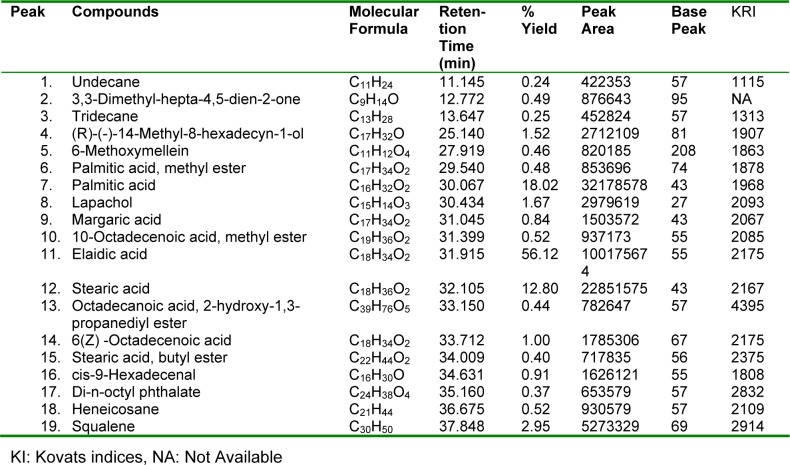Abstract
The chemical composition of Kigelia pinnata root oil extracted with n-hexane was analyzed by GC/GCMS. The antioxidant potential of the oil was compared to that of ethyl acetate and methanol extracts of the root. UV and IR spectroscopic techniques were used to carry out partial characterization of the oil and extracts. The free radical scavenging activity by spectrophotometric assay on the reduction of 1,1-diphenyl-2-picrylhydrazyl (DPPH) was examined while the total antioxidant activity (TAA) and relative antioxidant activity (RAA) were compared with standard antioxidant, α-tocopherol. The antioxidant activity (which correlated with the total phenolic content of the extracts) was assumed to be from the total phenolic content of the extracts. TAA was found to be higher in methanol extract (at 0.25 mg/mL). We hereby report for the first time the major component of the oil from the root of Kigelia pinnata to be elaidic acid (56.12 %). It is a reported toxicant which thereby underscores the risk in the use of the plant in traditional therapies.
Keywords: antioxidant, Kigelia pinnata, GC-MS, Free radical, alpha-tocopherol
Introduction
Antioxidant compounds are abundantly available in plants and play an important role in scavenging free radicals, thus providing protection to humans against oxidative DNA damage (Ponnan et al., 2006[43]). Although an excess of Reactive Oxygen Species, ROS (oxidative stress) can result in non-controlled oxidation and damage of cellular structures such as DNA, protein and membrane lipids. It is believed that the presence of ROS is essential in cells as they can act as key signaling molecules for the activation of the stress-responses and defense pathways (Halliwell, 2006[19]; Foyer and Noctor, 2005[17]). In humans, the plant polyphenols consumed through the diet are considered as effective protective agents against the ROS, which are known to be involved in the pathogenesis of aging and many degenerative diseases such as cardiovascular diseases and cancers (Virgili and Scaccini, 2003[51]; Kris-Etherton et al., 2004[25]). Numerous epidemiological studies have suggested a protective role of food polyphenols on human health (Arts and Hollman, 2005[5]). Recent studies have, however, stressed that the mechanisms of biological actions of polyphenols go beyond their ROS scavenging and metal chelating properties (Halliwell et al., 2005[20]) but may also offer indirect protection by activating endogenous defense systems and by modulating cellular signaling processes (Yang et al., 2001[54]; Feng et al., 2005[16]).
Kigelia africana (Lam.) Benth. belongs to the family of Bignoniaceae and has a wide geographical distribution in west and central Africa. The tree grows on riverbanks, wet areas along streams and on flood plains of Nigeria, Cameroon, Kenya, Guinea and Senegal. It can also be found in open woodland from KwaZulu-Natal to Tanzania, Chad, Eritrea, South Africa and Namibia (Ogbeche et al., 2002[38]; Abioye et al., 2003[1]). The tree is widely grown as an ornamental plant in tropical regions for its decorative flowers and unusual fruit that conceived the name 'sausage tree' (Roodt, 1992[44]).
The Bignoniaceae family is noted for the occurrence of iridoids, naphthoquinones, flavonoids, terpenes, tannins, steroids, coumarins, saponins and caffeic acid in the fruits, stem, leaves and roots (Akunyili and Houghton, 1993[2]; Houghton et al., 1994[23]; Moiden et al., 1999[35]; Weiss et al., 2000[52]; Picerno et al., 2005[42]; Bharti et al., 2006[11]; Asekun et al., 2007[9]; Owolabi and Omogbai, 2007[39]).
Though a large number of plants worldwide show strong antioxidant activities (Baratto et al., 2003[10]; Katalynic et al., 2006[24]), there is no report to our knowledge on the antioxidant properties of the root of this plant in any experimental protocol. In view of this, we have investigated the in vitro antioxidant effect of these extracts by DPPH assay and examined the phytochemicals in each extract. The plant root was selected for the study because of the reported phytochemicals which include iridoids, naphthoquinones and coumarins among others. The present study provides basic data on the natural antioxidant potential of Kigelia pinnata root for the food, pharmaceutical or cosmetic industries, and also offers scientific reference for the large scale usage and exploitation of Kigelia pinnata as a vital resource.
Experimental
Material and methods
Root of mature growing Kigelia pinnata tree was obtained from Abeokuta metropolis in Ogun state Nigeria during the dry season and was taxonomically authenticated and documented with the Voucher number LUT/3525 at the Herbarium of Botany Department at the University of Lagos, Lagos, Nigeria. The root material was air dried and pulverized.
Chemicals
Gallic acid, α-Tocopherol, 1,1-diphenyl-2-picrylhydrazyl (DPPH) were obtained from Sigma-Aldrich (Germany), Folin-Ciocalteu, reagent, Na2CO3, aluminium chloride, potassium acetate, phosphate buffer, K3Fe(CN)6, trichloroacetic, acid (TCA), ferric chloride, HCl, Dragendorff's reagent, potassium persulphate were obtained from the chemical store of the Chemical Sciences Department of the Redeemer's University, Nigeria, while bismuth nitrate, hexane, ethyl acetate and methanol were obtained from the Chemistry Department of the University of Ilorin, Ilorin, Nigeria. Solvents were re-distilled before use.
Instruments
A Gas Chromatography-Mass Spectroscopy, GC-MS system, GCMS-QP 2010 PLUS (Shimadzu Japan) interfaced with a finigan MAT ion trap detector ion source Temperature, was used with the following settings; 200 °C, interfaced Temp., 250 °C, solvent cut time; 2.50 min; relative detector mode, ACQ mode; Scan; start time - end time; 3.00 min - 46.00 min, event time, 0.50 sec; scan speed, 1428. Identification of the volatile component was carried out using the peak enrichment technique of reference compounds and as final confirmation of the peak identification by GC-MS, their spectral data were compared with those of NIST library mass spectra. The infra red spectrum was recorded on a Shimadzu (8400s) Fourier Transform-Infrared Spectroscopy (FT-IR) Spectrum spectrophotometer using KBr pellets; UV spectra were recorded using Shimadzu (1600s) Spectrophotometer.
Preparation of extract
The scheme for the extraction is shown in Figure 1(Fig. 1). The pulverized plant material weighing (420 g) was extracted exhaustively with n-hexane at room temperature for five days. The extract was decanted, filtered and concentrated under reduced pressure using rotary evaporator to afford 344 mg of a yellow oil which was coded KPRH. The remaining plant material was subsequently extracted with ethyl acetate for five days. The ethyl acetate-extract was decanted, filtered using a Whatman No.1 filter paper and concentrated in vacuo to yield 1.55 g of a reddish-brown extract coded KPRE. Finally, the remaining extracted plant material was extracted again for five days with methanol. The methanol-extract was decanted, filtered and concentrated in vacuo to yield 20.50 g thick blackish syrup coded KPRM. The extracts were stored in a cool dark place until further analysis.
Figure 1. Extraction schematics.
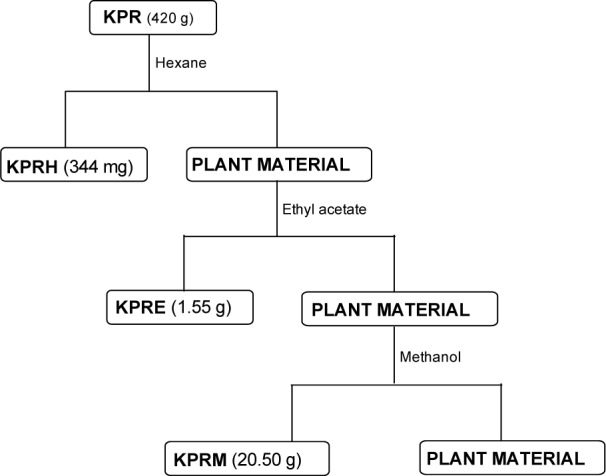
Phytochemical screening of the plant extracts
A small portion of the dry extract was used for the phytochemical screening for compounds including tannins, phlobatannins, flavonoids, terpenoids, alkaloids, cardiac glycosides, anthraquinone, saponins, and steroids in accordance with methods described by Harborne (1973[21]), Trease and Evans (1989[50]) and Sofowora (1993[48]) with minor modifications.
Determination of total phenolic composition
The amount of phenolic compound in the root extracts of Kigelia pinnata was determined with Folin Ciocalteu reagent using the method of (Ebrahimzadeh et al., 2008[13][14]). To 0.5 mL of each sample (two replicates) of plant extract methanol solution (1 mg/mL) was added 2.5 mL of 10 % Folin-Ciocalteu reagent and 2 mL of Na2CO3 (2 % w/v). The resulting mixture was incubated at 50 °C for 30 minutes. The absorbance of the samples was measured at 765 nm using UV/visible spectrophotometer. Concentrations for the extracts were extrapolated from a calibration curve of gallic acid using the formula y = 0.646x. Results were expressed as milligrams of gallic acid equivalent/gram of powder dissolved in methanol.
Determination of reducing power
The reducing powers of the extracts were evaluated according to the method of Oyaizu (1986[40]). The mixture containing 2.5 ml of 0.2 M phosphate buffer (pH 6.6) and 2.5 ml of K3Fe(CN)6 (1 % w/v) was added to 1.0 ml of the extract dissolved in distilled water. The resulting mixture was incubated at 50 °C for 20 min, followed by the addition of 2.5 ml of TCA (10 % w/v). The mixture was centrifuged at 3000 g for 10 min to collect the upper layer of the solution (2.5 ml), mixed with distilled water (2.5 ml) and 0.5 ml of FeCl3 (0.1 %, w/v). The absorbance was then measured at 700 nm against reference blank. Higher absorbance of the reaction mixture indicates higher reductive potential.
Estimation of antioxidant activity
The antioxidant acivity was measured using DPPH assay. This spectrophotometric assay uses the stable radical 1,1-diphenyl-1-picrylhydrazyl (DPPH) as a reagent (Amarowicz et al., 2004[3]). The DPPH free radical is commercially available and it was prepared at a 0.1 mM concentration (25 mg/L) in methanol, following the procedure described by Sánchez-Moreno et al. (1998[47]) and Larrauri et al. (1999[31]). The radical was protected from light. The absorbance at 518 nm was monitored in presence of different concentrations of extracts. Blank experiment was also carried out to determine the absorbance of DPPH before interacting with the extract. Absorbance was recorded to check the stability of the radical throughout the time of analysis. The total antioxidant activity (TAAs) and relative antioxidant activity (RAA) were calculated using the following equations (Arnao et al., 1998[4]).
TAA = 100x[(Abscontrol-Abssample)]/(Abscontrol)
and RAA = (TAA of test compound)/(TAA Standard compound)
Qualitative and quantitative analysis of Kigelia pinnata root-oil
The afore-mentioned GC/GCMS program was used. The compounds were identified on the basis of their retention times and mass-spectral fragmentation patterns compared with those of reference compounds stored on the spectrometer database and the NIST library. Quantification of identified constituents was performed by injecting 1 μl of the samples (on-column injector; hydrogen as carrier gas) and calculations from the electronic integration of the FID peak areas.
Statistical analysis
The group mean ± S.E.M. was calculated for each analyte and significant difference between means evaluated by analysis of variance (ANOVA). Post-hoc test analysis was done using the Duncan multiple comparison test. Values at p < 0.05 were considered as statistically significant.
Results and Discussion
Phytochemical screening
The phytochemical analysis conducted on the K. pinnata extracts revealed the presence of tannins, flavonoids, steroids phlobatannins, cardiac glycoside, terpenoids and saponins. The result is as shown in Table 1(Tab. 1). These phytochemicals are known to support bioactive activities in medicinal plants and may therefore be responsible for the antioxidant activities of the plant extracts. Tannins are generally known to be useful in the treatment of inflamed or ulcerated tissues and have remarkable activity in cancer prevention (Ruch et al., 1989[45]; Motar et al., 1985[36]). Thus, the presence of these constituents in Kigelia pinnata partly supports the common traditional use of plant in the treatment of cancer. Flavonoids have been shown to exhibit their actions through effects on membrane permeability, and by inhibition of membrane-bound enzymes such as the ATPase and phospholipase A2 (Li et al., 2003[32]), and this property may possibly explain the mechanisms of antioxidative action of K. pinnata root extract. Flavonoids serve as health promoting compound as a results of its anion radicals (Havsteen, 1983[22]). Alkaloid was conscupiously absent in the root of the study plant. Alkaloids have been associated with medicinal uses for centuries and one of their common biological properties is their cytotoxicity (Nobori et al., 1994[37]).
Table 1. The phytochemical components of Kigelia pinnata based on the preliminary extract screening.
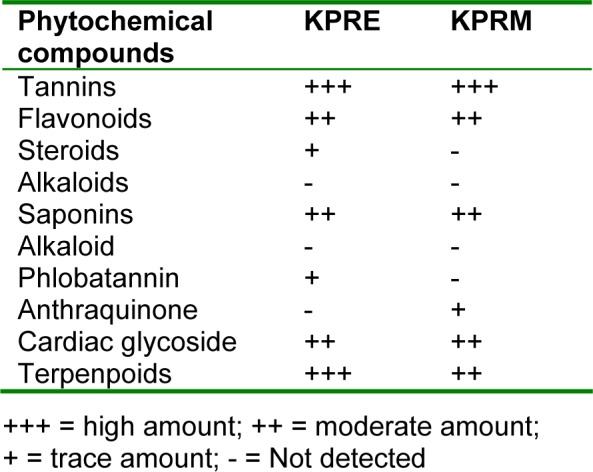
Kigelia pinnata root-oil composition
KPRH; UV (Hexane) λmax (log ε) 426 (3.4), 419.5 (3.4), 348.5 (4.0), 305.5 (4.0), 250.5 (2.3) nm; IR υmax 3429, 3007, 2955, 2854, 1743, 1710, 1465, 1379, 1166, 1100- 721 cm-1; In the GC-MS analysis, 19 bioactive phytochemicals were identified in the root oil of Kigelia pinnata as shown in Table 2(Tab. 2). Elaidic acid, (C18H34O2), Figure 2a(Fig. 2), with RT 31.915 with peak area 56.12 % was the major compound identified in the oil.
Table 2. Kigelia pinnata root-oil profile obtained from the GC/GCMS.
Figure 2. Structure of Elaidic acid and Lapachol.
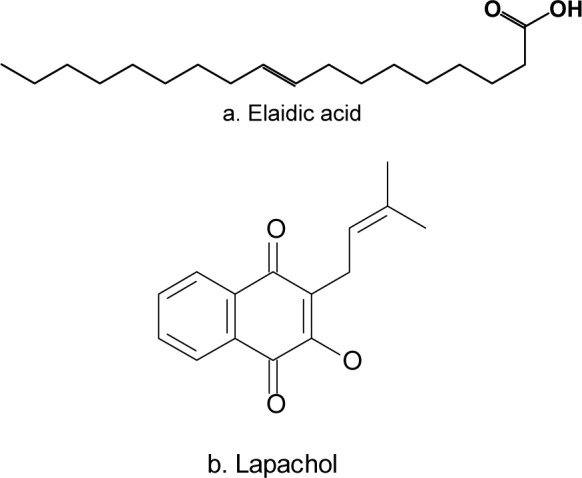
The biological importance and toxicity of elaidic acid, a trans fatty acid have remained controversial. Some were of the opinion that trans fatty acids increased fragility of red blood cells, changed the aggregation of thrombocytes (Ascherio et al., 1994[7], 1999[8]; Ascherio, 2002[6]) and evidenced their negative effects on the metabolism of linolenic acid and arachidonic acid (Larque et al., 2000[30]). It was established that they caused lack of essential fatty acids (Kummerow et al., 2004[27]), inhibited synthesis of prostaglandin (Kushi and Giovannucci, 2002[29]) and increased the risk of certain cancers. An increased risk of breast cancer has been associated with increasing levels of the trans-monounsaturated fatty acids palmitoleic acid and elaidic acid (Chajès et al., 2008[12]). Lately, it has been reported that incorporation of trans fatty acids into the phospholipids of the membranes affected its properties and mainly the activity of enzymes attached to the membrane, in fact, in recent times a positive relation has been established between allergic diseases and trans fatty acid consumption (Kritchevsky, 1997[26]; Stender and Dyerberg, 2004[49]). Elaidic acid has also been shown to have both 5α-reductase inhibitory activity and hair regrowth stimulation effects (Kuniyoshi et al., 2000[28]).
In view of the various reports on the toxicity of elaidic acid, the therapeutic effect of the plant should be weighed along side its toxicity when administered in folk medicine. Special attention may have to be paid to the extraction method.
Other notable compounds that are present include palmitic acid (18.02 %), stearic acid (12.08 %), squalene (2.95 %) and lapachol, Figure 2b(Fig. 2), (1.67 %), (R)-(-)-14-methyl-8-hexadecyn-1-ol (1.52 %) and 6(Z) -octadecenoic acid (1 %). Lapachol has been reportedly isolated from the root of the plant previously (Govindachari et al., 1971[18]). Lapachol and derivatives as constituents of plant extracts are well documented for anti-inflammatory, antimicrobial, and antineoplasic activities (Miranda et al., 2001[34]). The aqueous and methanol extracts of T. avellanedae for instance also showed antifungal, antinociceptive and antiedematogenic activities (Miranda et al., 2001[34]). Species that contain lapachol and several biogenetically related naphthoquinones (e.g., tahaebo, pau d'arco and lapacho roxo) are widely used in American folk medicine for the treatment of cancer, lupus, infections, wounds, and many other diseases (Sacau et al., 2003[46]). Other activities of lapachol and its derivatives include the prevention against Schistosoma mansoni cercarial skin penetration, Biomphalaria glabrata infection as well as forestalling embryo alteration in rats (Maganha et al., 2006[33]). It is also reported for its antioxidant activities (Wenceslau et al., 2006[53]), cytotoxicity in human Promyelocytic Leukemia HL-60 cell line (Perez-Sacau et al., 2007[41]), analgesic and antipsoriatic activities (Felicioa et al., 2002[15]).
Total phenolic content and reducing power potentials of the extract
The total phenolic content was also found to be higher in KPRE at 0.5 mg/mL when compared to that of KPRM (Figure 3(Fig. 3)). It is possible that the extraction solvent contributed to the difference observed in the total phenolic contents for KPRE and KPRM. Figure 4(Fig. 4) shows the reducing power potentials of the extracts in comparison with a standard, gallic acid at 700 nm. The reducing capacity of the extracts, another significant indicator of antioxidant activity was also found to be appreciable. In the reducing power assay, the presence of antioxidants in the sample would result in the reduction of Fe3+ to Fe2+ by donating an electron. The amount of Fe2+ complex was then monitored by measuring the formation of Perl's blue at 700 nm. Increasing absorbance indicates an increase in reductive ability. The results show that there was increase in the reductive capability of KPRH which peaked at around 0.4 mg/ml. This activity may be connected with the antioxidant capability of the extract.
Figure 3. Phenolic content of KPRE and KPRM as gallic acid equivalent/g of powder.
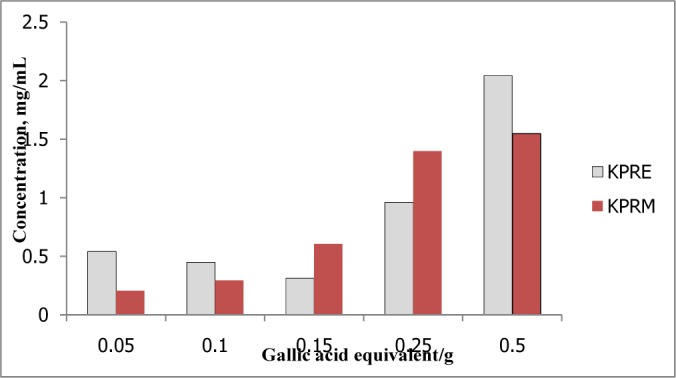
Figure 4. Reducing power activities of the extracts of Kigelia pinnata in comparison with a standard (Gallic acid) at λ, 700 nm.
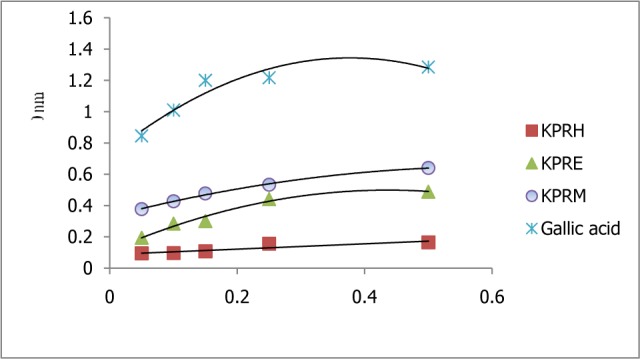
Free radical scavenging activities total and relative antioxidant activities
The in vitro antioxidant activities of the plant extracts (Figure 5(Fig. 5)) suggest synergistic antioxidant potentials though significantly lower compared to the standard, α-tocopherol. Generally, KPRE showed a higher antioxidant value and the TAA peaked at 0.25 mg/mL as the activity declined toward 0.5 mg/mL and further decline at higher concentration. KPRH showed an increase in TAA as concentration increases, which shows that it is dose dependent. KPRM showed the peak activity at 0.2 mg/mL. The trend line shows a decline at increase concentration in the RAA (Figure 6(Fig. 6)) except for KPRH. This implies that lower concentration of the KPRE and KPRM extracts may be required for effective antioxidant activities. The dose dependent trend observed for the KPRH could be as a result of synergistic free radical scavenging ability of compounds in the oil which apparently dampens the effect of the erucic acid.
Figure 5. Total antioxidant activities of KPRH, KPRE, KPRM and α-Tocopherol.
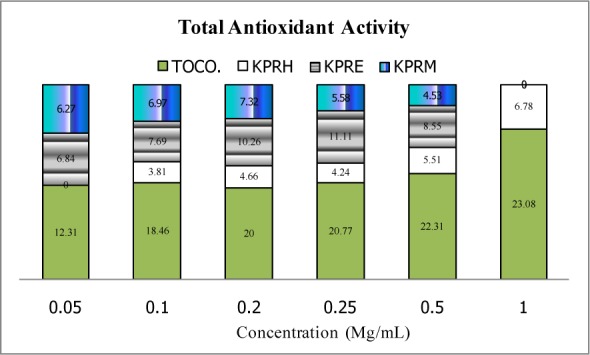
Figure 6. Relative antioxidant activities of KPRH, KPRE and KPRM.
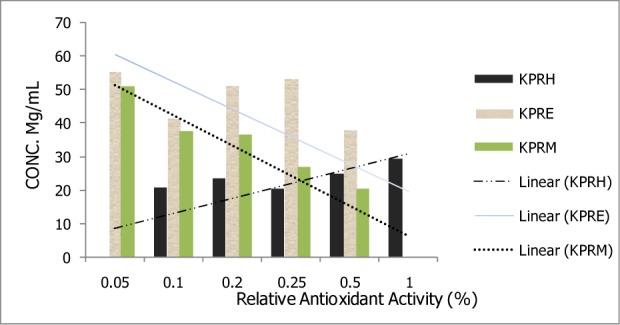
Conclusions
Kigelia pinnata root is rich in phytochemicals with proven antioxidant activities. The phytochemical analysis conducted on Kigelia pinnata extracts revealed the presence of tannins, flavonoids, steroids, phlobatannins, phenolics, anthraquinones, terpenoids and saponins. This study indicates that the ethyl acetate fraction of the plant root has high antioxidant activity against DPPH than the hexane and methanol extract. It is due to the presence of high content of phenolics, which could be the most effective in protecting the body against various oxidative stressors. The structures of phenolic compounds which exhibited antioxidant activity in the ethyl acetate fraction would need to be elucidated. Though the plant is highly regarded for its unique medicinal potencies due to the presence of lapachol, squalene, naphthoquinones etc, the content of elaidic acid content in the oil calls for caution in the use of the plant in traditional medical therapy.
References
- 1.Abioye AIR, Duru FIO, Noronha CC, Okanlawon AO. Aqueous extract of the bark of Kigelia africana reverses early testicular damage induced by methanol extract of Carica papaya. Niger J Health Biomedical Sci. 2003;2:87–89. [Google Scholar]
- 2.Akunyili D, Houghton P. Monoterpenoids and naphthaquinone from Kigelia pinnata. Phytochemistry. 1993;32:1015–1018. [Google Scholar]
- 3.Amarowicz R, Pegg RB, Moghaddam PR, Barl B, Weil JA. Free-radical scavenging capacity and antioxidant activity of selected plant species from Canadian prairies. Food Chem. 2004;84:551–562. [Google Scholar]
- 4.Arnao MB, Cano A, Acosta M. Total antioxidant activity in plant materials and its interest in food technology. Recent Dev Agric Food Chem. 1998;2:893–905. [Google Scholar]
- 5.Arts IC, Hollman PC. Polyphenols and disease risk in epidemiologic studies. Am J Clin Nutr. 2005;81:317–25. doi: 10.1093/ajcn/81.1.317S. [DOI] [PubMed] [Google Scholar]
- 6.Ascherio A. Epidemiologic studies on dietary fats and coronary heart disease. Am J Med. 2002;113:9S–12S. doi: 10.1016/s0002-9343(01)00986-x. [DOI] [PubMed] [Google Scholar]
- 7.Ascherio A, Hennekens C, Buring J, Master C, Stamper M, Willett W. Trans fatty acids intake and risk of myocardial infraction. Circulation. 1994;89:94–101. doi: 10.1161/01.cir.89.1.94. [DOI] [PubMed] [Google Scholar]
- 8.Ascherio A, Katan MB, Stampfer M. Trans fatty acids and coronary heart disease. N Engl J Med. 1999;340:1994–1998. doi: 10.1056/NEJM199906243402511. [DOI] [PubMed] [Google Scholar]
- 9.Asekun OT, Olusegun E, Adebola O. The volatile constituents of the leaves and flowers of Kigelia africana Benth. Flavour Fragr J. 2007;22:21–23. [Google Scholar]
- 10.Baratto MC, Tattini M, Galardi C, Pinelli P, Romani A, Visiolid F, et al. Antioxidant activity of Galloyl quinic derivatives isolated from Pistacia lentiscus leaves. Free Radical Res. 2003;37:405–412. doi: 10.1080/1071576031000068618. [DOI] [PubMed] [Google Scholar]
- 11.Bharti N, Singh S, Naqvi F, Azam A. Isolation and in vitro antiamoeboic activity of iridoids isolated from Kigelia pinnata. General Papers ARKIVOC. 2006;x:69–76. [Google Scholar]
- 12.Chajès V, Thiébaut AC, Rotival M, Gauthier E, Maillard V, Boutron-Ruault MC, et al. Association between serum trans-monounsaturated fatty acids and breast cancer risk in the E3N-EPIC Study. Am J Epidemiol. 2008;167:1312–1320. doi: 10.1093/aje/kwn069. [DOI] [PMC free article] [PubMed] [Google Scholar]
- 13.Ebrahimzadeh MA, Hosseinimehr SJ, Hamidinia A, Jafari M. Antioxidant and free radical scavenging activity of Feijoa sallowiana fruits peel and leaves. Pharmacologyonline. 2008;1:7–14. [Google Scholar]
- 14.Ebrahimzadeh MA, Poumorad F, Hafezi S. Antioxidant activities of Iranian Corn Silk. Turk J Biol. 2008;32:43–49. [Google Scholar]
- 15.Felício AC, Chang CV, Brandão MA, Peters VM, Guerra Mde O. Fetal growth in rats treated with lapachol. Contraception. 2002;66:289–293. doi: 10.1016/s0010-7824(02)00356-6. [DOI] [PubMed] [Google Scholar]
- 16.Feng R, Lu Y, Bowman LL, Qian Y, Castranova V, Ding M. Inhibition of activator protein-1, nf-k b, and mapks and induction of phase 2 detoxifying enzyme activity by chlorogenic acid. J Biol Chem. 2005;280:27888–95. doi: 10.1074/jbc.M503347200. [DOI] [PubMed] [Google Scholar]
- 17.Foyer CH, Noctor G. Oxidant and antioxidant signalling in plants: a reevaluation of the concept of oxidative stress in a physiological context. Plant Cell Environ. 2005;28:1056–71. [Google Scholar]
- 18.Govindachari TR, Patankar SJ, Vishvanathan N. Isolation and structure of two new dihydroisocoumarins from Kigelia pinnata. Phytochemistry. 1971;10:1603–1606. [Google Scholar]
- 19.Halliwell B. Oxidative stress and neurodegeneration: where are we now? J Chem. 2006;97:6:1634–58. doi: 10.1111/j.1471-4159.2006.03907.x. [DOI] [PubMed] [Google Scholar]
- 20.Halliwell B, Rafter J, Jenner A. Health promotion by flavonoids, tocopherols, tocotrienols, and other phenols: direct or indirect effects? antioxidant or not? Am J Clin Nutr. 2005;81:268–76. doi: 10.1093/ajcn/81.1.268S. [DOI] [PubMed] [Google Scholar]
- 21.Harborne JB. Phytochemical methods. London: Chapman and Hall; 1973. pp. 49–188. [Google Scholar]
- 22.Havsteen B. Flavonoids, a class of natural products of high pharmacological potency. Biochem Pharm. 1983;32:1141–1148. doi: 10.1016/0006-2952(83)90262-9. [DOI] [PubMed] [Google Scholar]
- 23.Houghton PJ, Photiou A, Uddin S, Shah P, Browning M, Jackson SJ, et al. Activity of Kigelia pinnata against melanoma and renal carcinoma cell lines. Planta Med. 1994;60:430–433. doi: 10.1055/s-2006-959525. [DOI] [PubMed] [Google Scholar]
- 24.Katalynic V, Milos M, Kulisic T, Jukic M. Screening of 70 medicinal plant extracts for antioxidant capacity and total phenols. Food Chem. 2006;94:550–557. [Google Scholar]
- 25.Kris-Etherton P, Lefevre M, Beecher G, Gross M, Keen C, Etherton T. Bioactive compounds in nutrition and health-research methodologies for establishing biological function: the antioxidant and anti-inflammatory effects of flavonoids on atherosclerosis. Annu Rev Nutr. 2004;24:511–38. doi: 10.1146/annurev.nutr.23.011702.073237. [DOI] [PubMed] [Google Scholar]
- 26.Kritchevsky D. Trans fatty acids and cardiovascular risk. Prostaglandins Leukot Essent Fatty Acids. 1997;57:399–402. doi: 10.1016/s0952-3278(97)90418-x. [DOI] [PubMed] [Google Scholar]
- 27.Kummerow FA, Zhou Q, Mahfouz MM, Smiricky MR, Grieshop CM, Schaeffer DJ. Trans fatty acids in hydrogenated fat inhibited the synthesis of the polyunsaturated fatty acids in the phospholipid of arterial cells. Life Sci. 2004;74:2707–2723. doi: 10.1016/j.lfs.2003.10.013. [DOI] [PubMed] [Google Scholar]
- 28.Kuniyoshi S, Ryuichiro K, Kokki S, Yoshihiro S, Hiriaki S, Tetsuya U. Steriod 5α-reductase inhibitory activity and hair regrowth stimulation effects of an extract from Boehmeria nipononivea. Biosci Biotechnol Biochem. 2000;64:875–877. doi: 10.1271/bbb.64.875. [DOI] [PubMed] [Google Scholar]
- 29.Kushi L, Giovannucci E. Dietary fat and cancer. Am J Med. 2002;113(9B):63S–70S. doi: 10.1016/s0002-9343(01)00994-9. [DOI] [PubMed] [Google Scholar]
- 30.Larque E, Perez-Llamas F, Puerta V, Giron MD, Suarez MD, Zamora S, et al. Dietary trans fatty acids affect docosahexaenoic acid concentration in plasma and liver but not brain of pregnant and fetal rats. Pediatr Res. 2000;47:278–283. doi: 10.1203/00006450-200002000-00021. [DOI] [PubMed] [Google Scholar]
- 31.Larrauri J, Sánchez-Moreno C, Ruperez C, Saura-Calixto F. Free radical scavenging capacity in the ageing of selected red Spanish wines. J Agric Food Chem. 1999;47:1603–6. doi: 10.1021/jf980607n. [DOI] [PubMed] [Google Scholar]
- 32.Li H, Wang Z, Liu Y. Review in the studies on tannins activity of cancer prevention and anticancer. Zhong-Yao-Cai. 2003;26:444–448. [PubMed] [Google Scholar]
- 33.Maganha J, Rocha ES, Brandao MAF, Peters VM, Guerra MO. Embryo development alteration in rats treated with lapachol. Braz Arch Biol Techn. 2006;49:927–934. [Google Scholar]
- 34.Miranda FGG, Vilar JC, Alves IAN, Cavalcanti SCH, Antoniolli AR. Antinociceptive and antiedematogenic properties and acute toxicity of Tabebuia avellanedae Lor. ex Griseb. inner bark aqueous extract. BMC Pharmacology. 2001;1:6. doi: 10.1186/1471-2210-1-6. [DOI] [PMC free article] [PubMed] [Google Scholar]
- 35.Moiden SV, Houghton PJ, Rock P, Croft SL, Aboagye-Nyame F. Activity of extracts and naphthoquinones from Kigelia pinnata against Trypanosoma brucei brucei and Trypanosoma brucei rhodesiense. Planta Med. 1999;65:536–540. doi: 10.1055/s-1999-14011. [DOI] [PubMed] [Google Scholar]
- 36.Motar MLR, Thomas G, Barbosa Fillo JM. Effects of Anacardium occidentale stem bark extract on in vivoinflammatory models. J Ethnopharm. 1985;95:139–142. doi: 10.1016/j.jep.2004.06.033. [DOI] [PubMed] [Google Scholar]
- 37.Nobori T, Miurak K, Wu DJ, Takabayashik LA, Carson DA. Deletion of the cyclin-dependent kinase-4 inhibitor gene inmultiple human cancers. Nature. 1994;368(6473):753–756. doi: 10.1038/368753a0. [DOI] [PubMed] [Google Scholar]
- 38.Ogbeche KA, Ogunbiyi YO, Duru FIO. Effect of methanol extract of Kigelia africana on sperm motility and fertility in rats. Niger. J Health Biomed Sci. 2002;2:113–116. [Google Scholar]
- 39.Owolabi OJ, Omogbai EKI. Analgesic and anti-inflammatory activities of the ethanolic stem bark extract of Kigelia africana (Bignoniaceae) Afr J Biotechnol. 2007;6:582–585. [Google Scholar]
- 40.Oyaizu M. Studies on products of browning reactions: antioxidant activities of products of browning reaction prepared from glucosamine. J Nutr. 1986;44:307–315. [Google Scholar]
- 41.Perez-Sacau E, Dıaz-Penate RG, Estevez-Braun A, Ravelo AG, Garcıa-Castellano JM, Pardo L, et al. Synthesis and pharmacophore modeling of naphthoquinone derivatives with cytotoxic activity in human promyelocytic leukemia HL-60 cell line. J Med Chem. 2007;50:696–706. doi: 10.1021/jm060849b. [DOI] [PubMed] [Google Scholar]
- 42.Picerno P, Autore G, Marzocco S, Meloni M, Sanogo R, Aquino RP. Antiinflammatory activity of verminoside from Kigelia africana and evaluation of cutaneous irritation in cell cultures and reconstituted human epidermis. J Nat Prod. 2005;68:1610–1614. doi: 10.1021/np058046z. [DOI] [PubMed] [Google Scholar]
- 43.Ponnan A, Perumal R, Sathiyavedu TS, Arabandi R. Antioxidant activity measured in different solvent fractions obtained from Mentha spicata Linn.: An analysis by ABTS decolorization assay. Asia Pac J Clin Nutr. 2006:119–124. [PubMed] [Google Scholar]
- 44.Roodt V. The Shell Field Guide to the Common Trees of the Okavango Delta and Moremi Game Reserve. Gaborone, Botswana: Shell Oil Botswana; 1992. Kigelia africana. [Google Scholar]
- 45.Ruch RJ, Cheng SJ, Klaunig JE. Prevention of cytotoxicity and inhibition of intercellular communication by antioxidant catechins isolated from Chinese green tea. Carcinogens. 1989;10:1003–1008. doi: 10.1093/carcin/10.6.1003. [DOI] [PubMed] [Google Scholar]
- 46.Sacau EP, Estévez-Braun A, Ravelo AG, Ferro EA, Tokuda H, Mukainaka T, et al. Inhibitory effects of lapachol derivatives on Epstein-Barr virus activation. Bioorg Med Chem. 2003;11:483–488. doi: 10.1016/s0968-0896(02)00542-4. [DOI] [PubMed] [Google Scholar]
- 47.Sánchez-Moreno C, Larrauri JA, Saura-Calixto F. A procedure to measure the antiradical efficiency of polyphenols. J Sci Food Agric. 1998;76:270–6. [Google Scholar]
- 48.Sofowora A. Medicinal plant and traditional medicine in Africa. Ibadan, Nigeria: Spectrum Books Ltd; 1993. p. 289. [Google Scholar]
- 49.Stender S, Dyerberg J. Influence of trans fatty acids on health. Ann Nutr Metab. 2004;48:61–66. doi: 10.1159/000075591. [DOI] [PubMed] [Google Scholar]
- 50.Trease GE, Evans WC. Pharmacognosy. 11th ed. London: Cassell and Collier Macmillan Publ; 1989. [Google Scholar]
- 51.Virgili F, Scaccini C. Nutritional phenolics and cardiovascular diseases. In: Johnson I, Williamson G, editors. Phytochemical functional foods. Boca Raton, FL: CRC Press; 2003. p. 2.5–2.17. [Google Scholar]
- 52.Weiss CR, Moideen SV, Croft SL, Houghton PJ. Activity of extracts and isolated naphthoquinones from Kigelia pinnata against Plasmodium falciparium. J Nat Prod. 2000;63:1306–1309. doi: 10.1021/np000029g. [DOI] [PubMed] [Google Scholar]
- 53.Wenceslau JPS, Souza DF, Oliveira MCF, Lemos TLG, Sousa AL, Trevisan MTS. Novel lapachol derivatives and their antioxidant activity. Nat Prod Comm. 2006;1:661–664. [Google Scholar]
- 54.Yang C, Landau J, Huang M-T, Newmark H. Inhibition of carcinogenesis by dietary polyphenolic compounds. Annu Rev Nutr. 2001;21:381–406. doi: 10.1146/annurev.nutr.21.1.381. [DOI] [PubMed] [Google Scholar]



